Physical Address
304 North Cardinal St.
Dorchester Center, MA 02124
Germinal matrix hemorrhage–intraventricular hemorrhage (IVH) is the commonest form of intracranial hemorrhage in the newborn and is characteristic of the premature infant. The incidence of IVH in premature infants was documented to decline from very high rates of 34% to 49% in the 1970s to approximately 20% in the late 1980s. , There has also been a modest reduction in the rates of severe IVH (grades III and IV), with a decline from 19% in 1993 to 15% by 2012. This decline, however, has not been consistent for all preterm infants, with minor reductions in severe IVHs only occurring among those of 26 weeks’ gestation or greater ( Fig. 131.1 ).
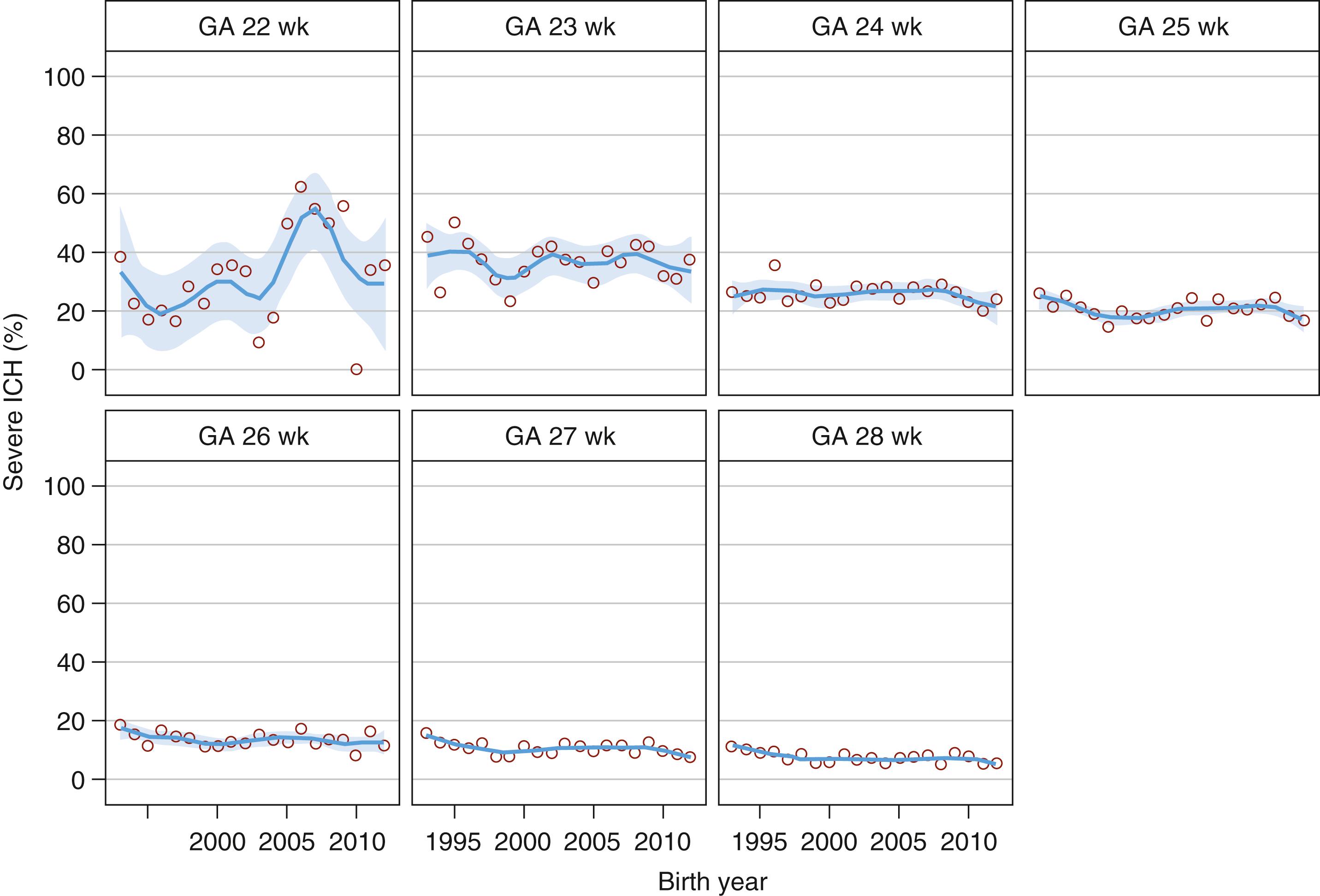
Unfortunately in the past decade the incidence of IVH has remained static, with an overall incidence of 25% ( Fig. 131.2 ). In one of the largest series, 535,682 very low-birth-weight infants were observed between 2009 and 2018 from 1022 neonatal intensive care units (NICUs) as part of the Vermont Oxford Network Very Low Birth Weight database (data provided from 2009 to 2018 from the Vermont Oxford Network database; see Figs. 131.2 and 131.3 ). The incidence of all grades of IVH remained static during this 9-year period at 24% to 26%, with the incidence of the severest forms of IVH (grades III and IV) being approximately 7%. It has been hypothesized that the rates of IVH may not be improving because of the greater number of extremely immature infants, with a higher risk of IVH, who are surviving. However, the data from the Vermont Oxford Network database from 2009 to 2018 demonstrate that the percentage of preterm infants weighing less than 750 g across this 9-year period remained at 16%.
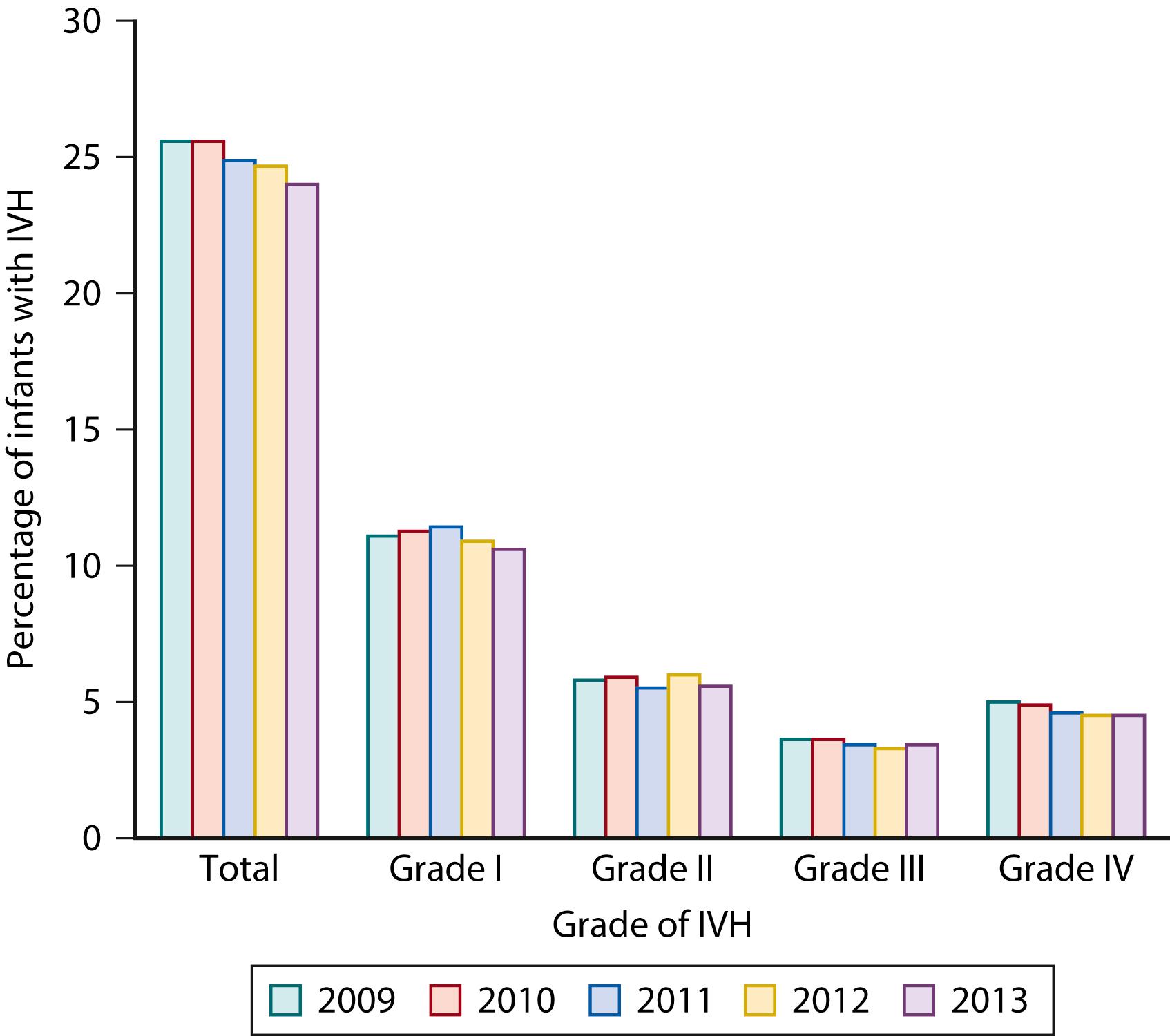
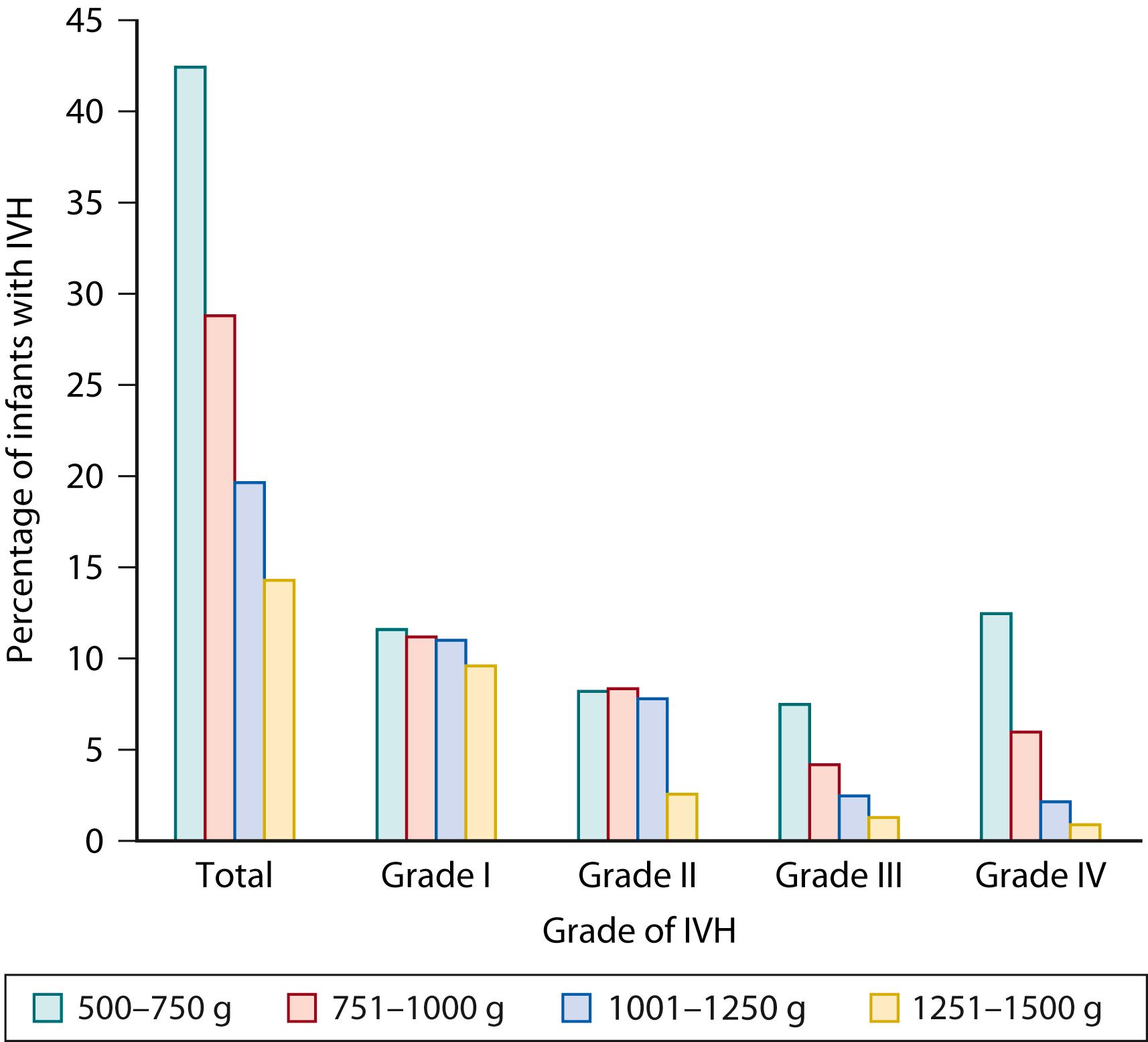
The Vermont Oxford Network database data also highlights the strong association between birth weight and risk for IVH (see Fig. 131.3 ). For infants weighing less than 750 g, the risk of any IVH is approximately threefold higher than for a preterm infant weighing more than 1250 g (44% vs. 16%), with a 10-fold higher risk of grade III–IV IVH (20% vs. 2%; see Fig. 131.3 ). For an infant weighing less than 750 g, an equal risk (approximately 10%) exists for developing grade I through grade IV IVH, while an infant weighing more than 1250 g has a 10% risk of grade I IVH but only a 1% risk of grade III or grade IV IVH (see Fig. 131.3 ). Thus, IVH remains a significant problem in the preterm infant, particularly for the most immature infants. Currently, in the United States approximately 57,000 very low-birth-weight infants are born each year, of whom approximately 14,000 will have IVH, and more than 2000 infants will have periventricular hemorrhagic infarction.
In this chapter, we briefly discuss the background of diagnosis and clinical presentation for IVH before a more detailed discussion of the neuropathology and pathogenesis of the lesion, highlighting both experimental and human study findings.
The most common clinical presentation for IVH is a clinically silent syndrome occurring in up to 50% of infants in whom even careful and serial clinical assessments may fail to reveal any abnormal signs indicative of the lesion. The timing of onset of IVH by clinical recognition is limited. From cranial ultrasound studies, it appears that the onset of IVH is by the first day of life in at least 50% of affected infants, with up to 90% of lesions present by 72 hours , and all lesions visible by 7 days. However, further progression of an initial IVH occurs in 20% to 40% of the affected infants, with the maximal extent of the lesion generally seen by 3 to 5 days after the initial diagnosis. ,
The diagnosis of IVH is most commonly established at the bedside of the sick preterm infant with use of portable cranial ultrasonography, and vast experience demonstrates the reliability and versatility of cranial ultrasonography for the diagnosis of IVH. , The determination of blood in the germinal matrix is best made on the coronal ultrasound scan at the level of the caudothalamic notch, whereas the determination of the amount of blood in the lateral ventricles is most accurate on the parasagittal ultrasound scan ( Fig. 131.4 ).
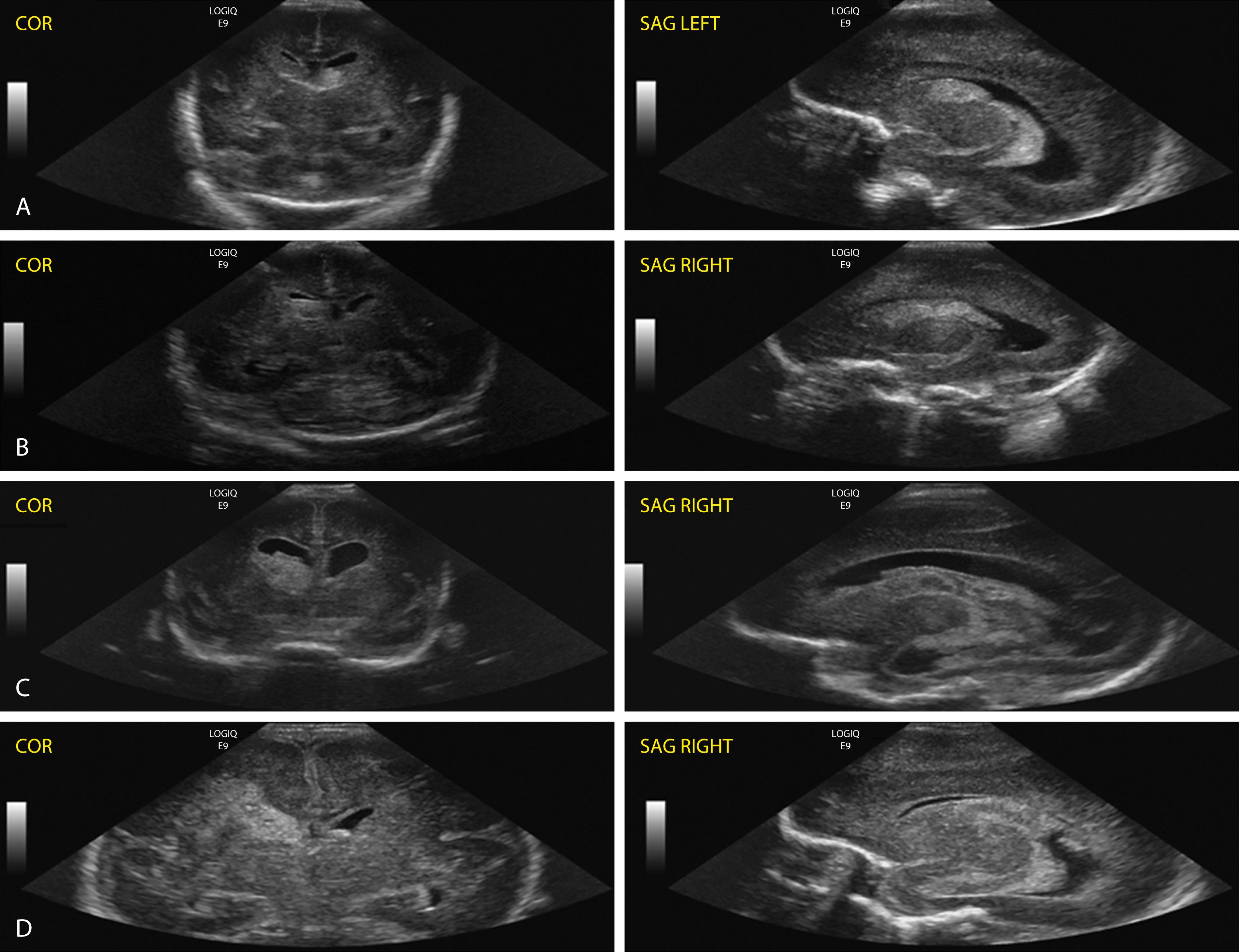
In comparison with the bedside technique of cranial ultrasonography, computed tomography (CT) and magnetic resonance imaging (MRI) have the major disadvantage of requiring the sick premature infant to be transported to another site. Historically, CT played a role in the early diagnosis of IVH and clearly defined the site and extent of IVH in the premature infant. , , , However, concerns about the potential effects of ionizing radiation on the developing nervous system suggest that one should restrict the use of CT to neurosurgical emergencies in the newborn. MRI provides excellent images of IVH, but the major advantage of MRI lies in its superior ability to demonstrate the nature and severity of any parenchymal injury ( Fig. 131.5 ) alongside a more extensive evaluation of the cerebral white matter, deep nuclear gray matter, cerebellum, and gyral development as indicators of additional neuropathology, which aids in prognosis.
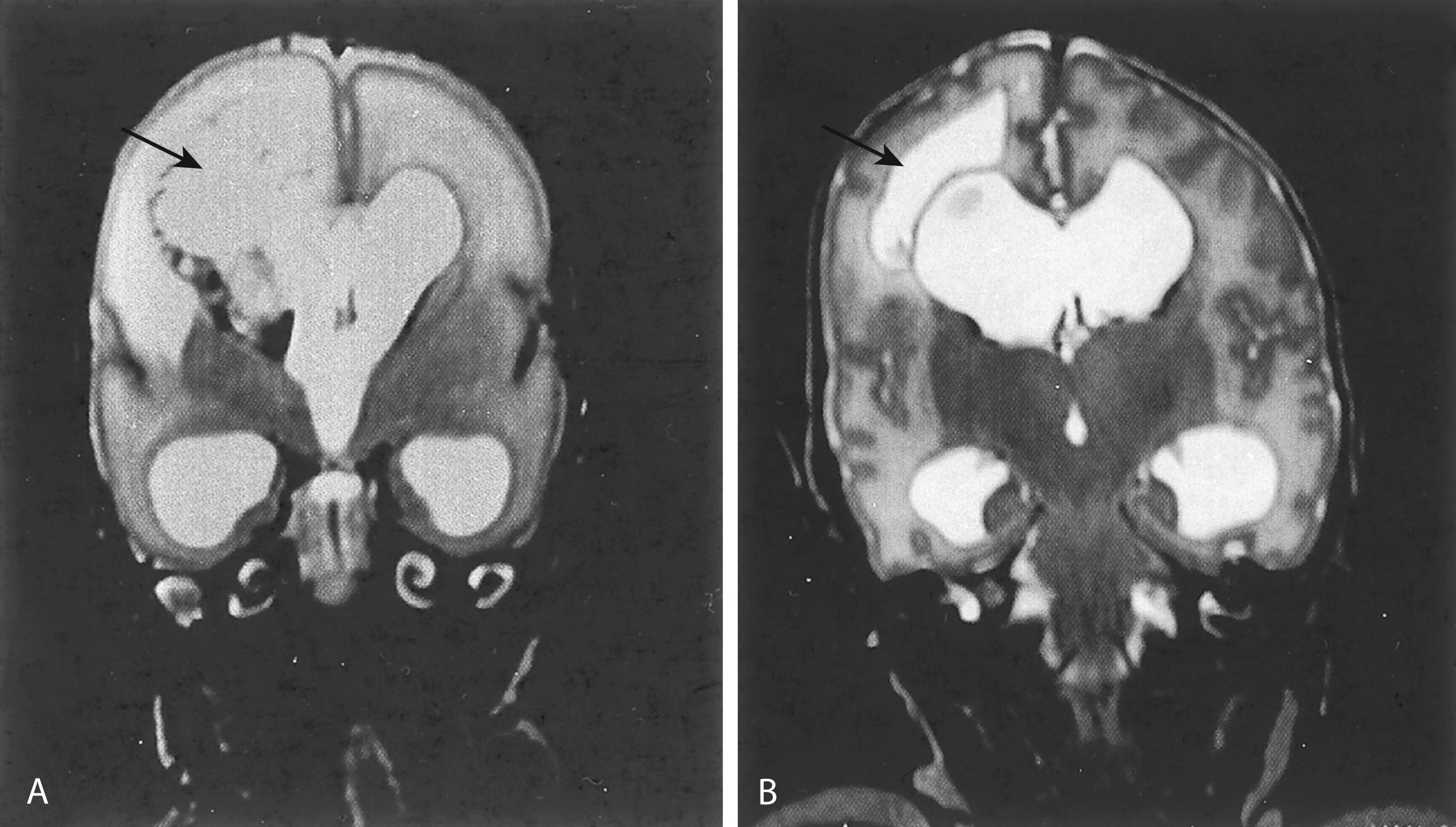
In addition to imaging for the diagnosis of IVH, lumbar puncture can provide a characteristic cerebrospinal fluid (CSF) profile consisting initially of increased red blood cell count and elevated protein content, followed shortly by xanthochromia and depressed glucose content. The degree of elevation of CSF protein content correlates approximately with the severity of the hemorrhage. Exploratory work has analyzed the ability of various maternal and neonatal biomarkers for the early prediction and identification of IVH. These studies have analyzed a range of candidate markers, including S-100 β, activin A, and erythropoietin, but the most commonly studied analytes have been proinflammatory cytokines (interleukin [IL]-6, IL-8, tumor necrosis factor [TNF]α). Results from different groups have been conflicting, however, and none of the findings from these studies have been validated as being specific for IVH, which limits their potential usefulness.
During the last decade, amplitude-integrated electroencephalography has been used to study the vulnerable period of the first week of life, revealing the association of abnormal patterns with high-grade IVH. Amplitude-integrated electroencephalography may serve as a useful tool to assist in understanding the presence of IVH.
The grading system most commonly used for IVH in the infant was first reported by Papile and colleagues and is based on the presence and amount of blood in the germinal matrix and the lateral ventricles seen on any form of neuroimaging ( Table 131.1 and Fig. 131.4 ). Grade I represents hemorrhage confined to the subependymal germinal matrix, grade II represents hemorrhage within the lateral ventricles without ventricular dilatation, grade III represents hemorrhage with ventricular dilatation and/or hemorrhage occupying more than 50% of the ventricle, and grade IV represents parenchymal hemorrhage. Although grade IV IVH is now recognized principally as a periventricular hemorrhagic infarction rather than a simple extension of IVH, most reports continue to classify the cranial ultrasonography findings according to this earlier established classification system, and because of its common pathway of pathogenesis (as discussed further below).
| Severity | Description |
|---|---|
| Grade I | Germinal matrix hemorrhage with no or minimal intraventricular hemorrhage (10% of ventricular area on parasagittal view) |
| Grade II | Intraventricular hemorrhage (10%–50% of ventricular area on parasagittal view) |
| Grade III | Intraventricular hemorrhage (>50% of ventricular area on parasagittal view; usually distends lateral ventricle) |
The clinical risk factors for IVH have been studied using two scientific approaches: first, by experimental and case-control studies outlining factors related to the pathogenesis in a preterm infant; and second, by epidemiologic or registry-type studies that may also identify factors related to therapeutic or NICU factors. Clinical variables commonly identified as contributing to the risk of IVH include lower gestational age, lack of corticosteroids antenatally, clinical chorioamnionitis, male sex, significant delivery room resuscitation, mechanical ventilation, and hypotension requiring multiple inotropes, among other variables. A study across the Canadian Neonatal Network of 19,507 preterm infants admitted to 17 NICUs during an 18-month period demonstrated that on Bayesian hierarchic logistic regression modeling, 30% of the risk of high-grade IVH was related to baseline population risks (male sex, gestational age, initial severity of illness, and outborn status). An additional 14% of the risk was associated with admission-day therapies, such as acidosis and hypotension that require intervention, and another 31%, the largest fraction of variation, was related to NICU characteristics. NICUs with greater patient volumes and neonatology staffing had lower rates of severe IVH. These findings that NICU structure and care practices may influence the risk of IVH are supported by other findings and suggest that high patient load and neonatal physician experience may be associated with improved care practices and reduction in the risk of severe IVH. The variation between NICUs in registry data in the incidence of IVH does not appear to relate to differences in the interpretation of cranial ultrasound scans.
More recently, routine nursing care interventions have been proposed to avoid (rapid) fluctuations in cerebral blood flow (CBF) during routine care, resulting in reductions in IVH. These interventions are especially important during the first 72 postnatal hours and include positioning the head in a midline position to enable optimal cerebral venous drainage and elevating the head of the incubator 15 to 30 degrees upwards to facilitate cerebral venous outflow by promoting hydrostatic cerebral venous drainage. The results of a recently published randomized controlled trial (RCT) indicate that maintaining an elevated head position during the first four postnatal days was associated with a lower risk of developing a germinal matrix and intraventricular hemorrhage (GMH-IVH). Other nursing interventions include avoidance of elevation of the legs during diaper change and slow arterial/intravenous flushing and slow arterial blood withdrawal. In a recent published RCT using all four of these interventions as a bundle, there was a lower risk of developing a GMH-IVH (any degree), cystic periventricular leukomalacia, and/or mortality (adjusted odds ratio [OR] 0.42, 95% confidence interval [CI] 0.27 to 0.65). In the group receiving the bundle, also severe GMH-IVH, cystic periventricular leukomalacia, and/or death were less often observed (adjusted OR 0.54, 95% CI 0.33 to 0.91 HYPERLIN ).
Controversy remains over the role of indomethacin in reducing the risk of IVH. In a number of clinical trials, indomethacin treatment has been shown to reduce the incidence of IVH. , Secondary analyses of a multicenter study based on sex have shown that indomethacin treatment reduces the rate of IVH in male infants but not in female infants. Despite these early encouraging findings, across all of the 19 RCTs that have used indomethacin treatment, it was not demonstrated to improve neurodevelopmental outcomes in preterm infants. Thus, indomethacin prophylaxis has immediate benefits of reduction in symptomatic patent ductus arteriosus and severe IVH; however, this does not appear to impact long-term neurodevelopmental outcomes. Given these findings, variable practices remain across NICUs in relation to the use of prophylactic indomethacin.
The neuropathology of IVH is considered best in terms of the site of origin, that is, primarily the germinal matrix, the spread of the hemorrhage throughout the ventricular system, the neuropathologic consequences of the hemorrhage, and the neuropathologic accompaniments not necessarily related directly to the IVH.
The basic lesion in germinal matrix hemorrhage–IVH is bleeding into the subependymal germinal matrix. During the final 12 to 16 weeks’ gestation, this matrix becomes less and less prominent and is essentially absent by term. This region is highly cellular, gelatinous in texture, and richly vascularized, as would be expected for a structure with active cellular proliferation. Moreover, studies show that massive numbers of neurons transit through the germinal matrix, raising the possibility that this process is impeded by even low-grade IVH.
The site of origin of IVH characteristically is the subependymal germinal matrix. This region is comparable to that often referred to as the median ganglion eminence. This cellular region immediately ventrolateral to the lateral ventricle serves initially as a source of cerebral neuronal precursors between approximately 10 and 20 weeks’ gestation. The region also gives rise to later-migrating neurons, primarily GABAergic interneurons, destined for the thalamus in the third trimester. The subventricular zone dorsal and lateral to the angle of the lateral ventricle gives rise to the late migratory neurons destined for the cerebral cortex. Later in the third trimester, the matrix generates glial precursors that will become cerebral oligodendroglia and astrocytes. The germinal matrix undergoes a progressive decrease in size, from a width of 2.5 mm at 23 to 24 weeks, to 1.4 mm at 32 weeks, to nearly complete involution by approximately 36 weeks. , The many thin-walled vessels in the matrix are vulnerable to bleeding. Hemorrhage from the choroid plexus occurs in nearly 50% of infants with germinal matrix hemorrhage and IVH, and in more mature infants especially, it may be the exclusive site of origin of IVH. It is important to additionally note that these interneurons transit through GM until well after the third trimester in what becomes the subventricular zone.
The vascular site of origin of germinal matrix hemorrhage within the microcirculation of this region appears to be the prominent endothelial-lined vessels of the matrix and not the arterioles or arteries. The vessels in free communication with the venous circulation appear to be of particular importance, such as the capillary-venule junction or small venules. This has been shown by histochemical studies of germinal matrix vessels at the site of hemorrhage and by the emergence of solution into the germinal matrix hemorrhage from postmortem injection into the jugular veins but no emergence of solution into the germinal matrix hemorrhage from injection into the carotid artery.
Finally, there are key structural differences in the germinal matrix that may increase the vulnerability of the immature vasculature. These include the extracellular matrix of the cerebral vasculature that contains laminin, fibronectin, collagen IV, and perlecan for structural stability of blood vessels. In both human fetuses and premature infants, fibronectin expression is lower in the germinal matrix than in the cortical mantle or white matter anlagen. Low-dose prenatal betamethasone treatment, which is known to reduce the risk of IVH by 50%, enhances fibronectin level by 1.5-fold to twofold. Because fibronectin provides structural stability to the blood vessels, its reduced expression in the germinal matrix may contribute to the fragility of germinal matrix vasculature and its propensity to hemorrhage in premature neonates. In addition, the expression of collagen type IV α 1 and α 2 chains increases with advancing gestational age. Some studies have suggested that accumulated collagen in the blood vessels themselves does not differ in the immature germinal matrix. Cytoskeletal vascular stabilizing influences from both pericytes and astrocyte end feet seem to be lacking in the immature germinal matrix, which may also contribute to the fragility of the germinal matrix vasculature and its propensity to hemorrhage. Finally, the molecular features that may underlie the fragility of germinal matrix microvasculature have been described.
In approximately 80% of patients with germinal matrix hemorrhage, blood enters the lateral ventricles and spreads throughout the ventricular system. Blood proceeds through the foramina of Magendie and Luschka and tends to collect in the basilar cisterns in the posterior fossa. With substantial collections, the blood may incite an obliterative arachnoiditis over days to weeks, with impairment of CSF flow. Other sites at which particulate blood clot may lead to impaired CSF dynamics are the aqueduct of Sylvius and the arachnoid villi.
Several major neuropathologic states occur as apparent consequences of IVH, including, in temporal order of occurrence, germinal matrix destruction, periventricular hemorrhagic infarction, and post-hemorrhagic hydrocephalus.
The destruction of germinal matrix and, perhaps most important, of its glial precursor cells is an associated consequence of germinal matrix hemorrhage. , The hematoma is replaced frequently by a cyst, the walls of which include hemosiderin-laden macrophages and reactive astrocytes. Destruction of glial precursor cells in the germinal matrix may have a deleterious influence on subsequent brain development and neurodevelopmental outcomes (see later).
Approximately 15% of infants with IVH also exhibit a characteristic parenchymal lesion, periventricular hemorrhagic infarction. The incidence of this lesion increases with decreasing gestational age, such that in infants weighing 500 to 750 g, periventricular hemorrhagic infarction accounts for approximately one-quarter of all cases of IVH (see Fig. 131.3 ), with an absolute incidence among these infants of approximately 10%. The neuropathology of periventricular hemorrhagic infarction consists of a relatively large region of hemorrhagic necrosis in the periventricular white matter, just dorsal and lateral to the external angle of the lateral ventricle. The necrosis is strikingly asymmetric— in the largest series reported, 67% of such lesions were exclusively unilateral, and, in virtually all of the remaining cases, they were grossly asymmetric, even though bilateral. Approximately half of the lesions are extensive and involve periventricular white matter from the frontal to the parietooccipital regions. Approximately 80% of cases are associated with large IVH, and commonly (and mistakenly), the parenchymal hemorrhagic lesion is described as an “extension” of the hemorrhage. That simple extension of blood into cerebral white matter from germinal matrix or lateral ventricle does not account for the periventricular hemorrhagic necrosis that has been shown clearly by several neuropathology studies. , , , Microscopic study of this periventricular hemorrhagic necrosis indicates that the lesion is a hemorrhagic infarction . The studies of Gould and colleagues and Takashima and colleagues emphasize that the hemorrhagic component of the infarction tends to be most concentrated near the ventricular angle, where the medullary veins draining the cerebral white matter become confluent and ultimately join the terminal vein in the subependymal region. Thus it appears that periventricular hemorrhagic necrosis occurring in association with large IVH is, in fact, a venous infarction.
The pathogenesis of periventricular hemorrhagic infarction appears to be related directly to the associated germinal matrix hemorrhage–IVH, as the association of large asymmetric germinal matrix hemorrhage–IVH and progression to ipsilateral periventricular hemorrhagic infarction has been clearly documented. , , These data raise the possibility that the IVH or its associated germinal matrix hemorrhage may lead to obstruction of the terminal or collecting veins with secondary hemorrhagic venous infarction. , , This pathogenetic formulation has received further support from imaging studies. Doppler determinations of blood flow velocity demonstrated obstruction of flow in the terminal vein by the ipsilateral germinal matrix hemorrhage during the evolution of the infarction in a living premature infant. In addition, an MRI study of acute periventricular hemorrhagic infarction showed an appearance consistent with a combination of intravascular thrombi and perivascular hemorrhage along the course of the medullary veins within the area of infarction. A pathogenetic scheme illustrating most examples of periventricular hemorrhagic infarction is shown in Fig. 131.6 .
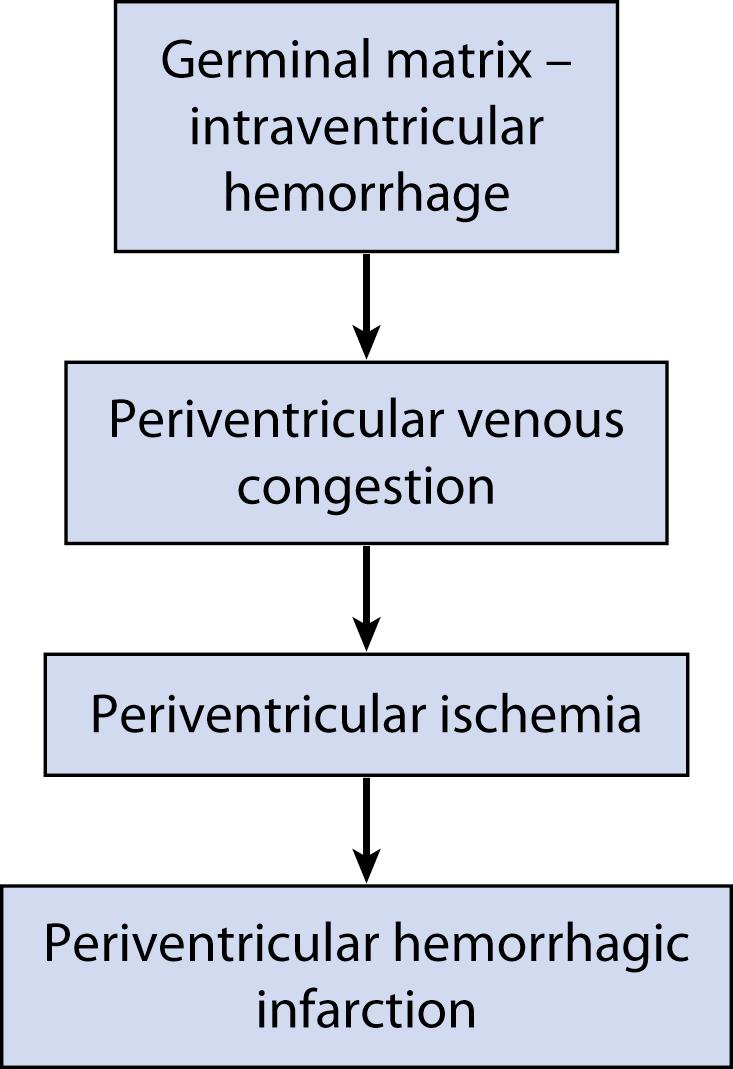
Finally, atypical cases of periventricular hemorrhagic infarction have been described, with atypical timing with fetal or very late presentation without a related deteriorating clinical condition. In these cases, a high proportion (>50%) carried either the factor V Leiden (G1691A) mutation, or variants in the MTHFR or COL4A1 genes.
A third neuropathologic consequence of IVH is progressive post-hemorrhagic ventricular dilatation (PHVD) (i.e., hydrocephalus ). The likelihood of and the speed of evolution of hydrocephalus after IVH is related directly to the quantity of intraventricular blood. Thus, with large IVH, hydrocephalus may evolve over days ( acute hydrocephalus), and with smaller IVH, the process usually evolves over weeks ( subacute-chronic hydrocephalus).
Acute hydrocephalus is accompanied by particulate blood clots, which may impair CSF absorption by obstruction of the arachnoid villi. This mechanism may be likely in the newborn because of the presence of only microscopic arachnoid villi and not the larger, later-appearing arachnoid granulations. Other contributing factors to the development of acute hydrocephalus may include an impaired ability to mediate clot lysis due to extremely low plasminogen levels and elevations in plasminogen activator inhibitor levels in the CSF of infants with recent IVH.
Subacute-chronic hydrocephalus relates most commonly either to obliterative arachnoiditis in the posterior fossa resulting in obstruction of fourth ventricular outflow or flow through the tentorial notch or to aqueductal obstruction by blood clot, disrupted ependyma, and reactive gliosis. , ,
Several neuropathologic states are commonly associated with but not directly caused by IVH. The most common findings include periventricular leukomalacia, pontine neuronal necrosis, and loss of cerebellar volume.
Periventricular leukomalacia was observed in 75% of one series of infants who died with IVH. Although all of the infants in this series had an IVH, only 42% died secondary to cerebral hemorrhage. The remaining causes of mortality included infection, respiratory failure, and circulatory insufficiency. In contrast to parenchymal hemorrhagic infarction, periventricular leukomalacia is a generally symmetric, nonhemorrhagic, and associated with apparent ischemic white matter injury in the arterial end zones ( Table 131.2 ). The frequent association of periventricular leukomalacia with IVH has also been emphasized in three other neuropathology reports. , Takashima and colleagues suggested periventricular hemorrhagic infarction and hemorrhagic periventricular leukomalacia may be distinguishable in part on the basis of topography. Hemorrhagic periventricular leukomalacia has a predilection for periventricular arterial border zones, particularly in the region near the trigone of the lateral ventricles. Venous infarction is particularly prominent anteriorly, as the lesion radiates from the periventricular region at the site of confluence of the medullary and terminal veins and assumes a roughly triangular, fan-shaped appearance in periventricular white matter. The mechanism of injury is not fully defined but is associated with the complex interaction of ischemia and inflammation, with some studies highlighting the importance of injury to preoligodendrocytes secondary to these processes. , Injury to the white matter axons and subplate neurons is a frequent accompaniment of periventricular leukomalacia. A potential role for activated microglia in the process is suggested by the demonstration in brains with IVH of CD68 microglia and damaged axons in cerebral white matter. Another study showed that oligodendrocyte precursors have critical roles in regulation of angiogenesis in developing white matter tracts, and that inactivation of hypoxia-inducible factor signaling within such precursors resulted in cystic lesions reminiscent of periventricular leukomalacia.
| Term Disturbance | Symmetry | Gross Hemorrhage | Probable Site of Circulatory Insult |
|---|---|---|---|
| Periventricular leukomalacia | Predominantly symmetric | Uncommon | Arterial |
| Periventricular hemorrhagic infarction | Predominantly asymmetric | Invariable | Venous |
IVH, in addition to other supratentorial brain injuries, has been shown to be associated with reductions in cerebellar volume. , Two key mechanisms have been proposed for the association of IVH with reduced cerebellar lesions. The first is the direct toxicity of hemosiderin over the surface of the cerebellum, impairing the proliferation of the external granular layer. This hypothesis was initially raised by Messerschmidt and colleagues, who described acquired cerebellar growth failure in a series of 35 premature infants who had prominent hemosiderin over the cerebellar surface. In that study, all of the infants had IVH and two thirds developed post-hemorrhagic hydrocephalus. Consistent with this hypothesis of IVH-associated hemosiderin influencing cerebellar growth, a more recent study of 172 preterm infants found an association between IVH and smaller cerebellar volumes on both sides, suggesting a global impact from surface-based hemosiderin associated with the IVH. A second mechanism potentially involved in the cerebellar underdevelopment in association with IVH involves the loss of remote transsynaptic effects from cerebral neural connections. This mechanism represents a maturation-distinctive form of diaschisis, characterizing a loss of function in a brain area neutrally connected to but remote from a separate lesioned brain area. A relationship between IVH and contralateral connected cerebellum has been demonstrated, supporting this hypothesis. In a study of 74 infants born at less than 32 weeks with an MRI scan at term, it was found that a unilateral IVH was significantly associated with a smaller cerebellar hemisphere on the contralateral side. In the crossed cerebellocerebral deficits, the loss of cortical input could disturb both primarily the cerebellum and the dentatorubrothalamic cortical pathway. For further information on cerebellar hypoplasia, see Chapter 129 .
The pathogenesis of IVH is considered best in terms of intravascular, vascular, and extravascular factors. Clearly, the pathogenesis of IVH is multifactorial, and thus different combinations of these factors are operative in different patients.
Intravascular factors are those that relate primarily to the regulation of blood flow, pressure, and volume in the microvascular bed of the germinal matrix ( Box 131.1 , Fig. 131.7 ).
Fluctuating blood pressure in pressure-passive circulation
Increase in cerebral blood flow—systemic hypertension in the setting of a pressure-passive circulation, rapid volume expansion, hypercarbia, decreased hematocrit, decreased blood glucose level
Increase in cerebral venous pressure—venous anatomic arrangement, labor and vaginal delivery, respiratory disturbance, head positioning
Decrease in cerebral blood flow (followed by reperfusion)—systemic hypotension
Platelet and coagulation disturbance
Tenuous capillary integrity—the germinal matrix is an involuting remodeling capillary bed with deficient vascular lining and a large vascular and luminal area
Vulnerability of matrix capillaries to hypoxic-ischemic injury—the area has a high requirement for oxidative metabolism and lies at a vascular border zone
Become a Clinical Tree membership for Full access and enjoy Unlimited articles
If you are a member. Log in here